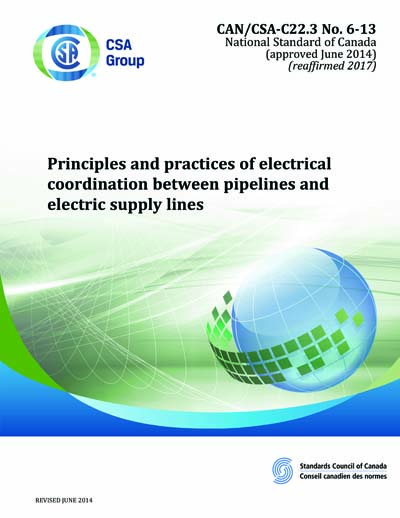Historical
CAN/CSA C22.3 No. 6-2013 (R2017)
Principles and practices of electrical coordination between pipelines and electric supply lines
A revision was published as notification that this is now a National Standard of Canada. To download any revisions and/or register for email notification of future revisions click here
Preface
This is the third edition of CSA C22.3 No. 6, Principles and practices of electrical coordination between pipelines and electric supply lines, one of a series of Standards issued by CSA Group under the Canadian Electrical Code, Part III. It supersedes the previous editions, published in 1991 and 1987. The first edition of this Standard was the result of work done by a task force organized by the committees on the gas and oil pipeline codes in order to consider the effects of electric power lines on pipelines. In addition to a general update, the following key revisions have been made in this edition of CSA C22.3 No. 6: a) clarification that the Standard applies to transmission supply lines; b) guidance and an informative annex on ac corrosion on pipelines; c) guidance and an informative annex on underground transmission cables; d) an annex, with examples, discussing the sensitivity of induction to various parameters; e) updated criteria and an informative annex related to the use of gradient control mats; and f) updated requirements for the reduction of adverse effects during power line fault conditions.Scope
1.1 This Standard sets forth methods of electrical coordination between pipelines and alternating current (ac) supply lines* having line-to-line voltages greater than 60 kV that are simultaneously or separately installed as follows: a) a pipeline located on a power line right-of-way or a power line located on a pipeline right-of-way; b) a pipeline right-of-way located parallel to a power line right-of-way, or vice versa, where the adjacent right-of-way boundaries are within 300 m of each other; and c) laterals and extensions to the pipelines described in Item (a) or (b). * Referred to in this Standard as power lines. Notes: 1) Power lines operating at voltages lower than 60 kV can, in some situations, induce significant voltages on parallel pipelines. 2) The contribution of the third harmonic to induction on pipelines has been observed in some situations. Industry understanding of the impact on pipeline induction from harmonics on the electric transmission system is not mature at this time; material on the subject will be considered in a future update to this Standard. 3) Induction on pipelines is influenced by factors in addition to the distance between parallel power lines and pipelines, e.g., the length of the parallelism and the power line current. Based on engineering analysis, it can be necessary for the parties involved to apply the principles and practices outlined in this Standard in situations where parallel rights-of-way are separated by more than the distance specified in Clause 1.1(b), e.g., in cases of parallels longer than 5 km. 1.2 This Standard describes mutual interference effects between pipelines and power lines and provides guidelines that, when used in the design, construction, operation, and maintenance of either facility, will reduce these effects. 1.3 This Standard recommends acceptable interference levels and minimum required separation between facilities. 1.4 The requirements of this Standard may also be applied to piping in refineries, tank farms, compressor and metering stations, and similar facilities. 1.5 This Standard contains requirements supplementary to the requirements of CAN/CSA-Z662, CAN/CSAC22.3 No. 1, and CSA C22.3 No. 4. 1.6 Geomagnetically induced currents (GICs) are not within the scope of this Standard. 1.7 In this Standard, shall is used to express a requirement, i.e., a provision that the user is obliged to satisfy in order to comply with the standard; should is used to express a recommendation or that which is advised but not required; and may is used to express an option or that which is permissible within the limits of the standard. Notes accompanying clauses do not include requirements or alternative requirements; the purpose of a note accompanying a clause is to separate from the text explanatory or informative material. Notes to tables and figures are considered part of the table or figure and may be written as requirements. Annexes are designated normative (mandatory) or informative (non-mandatory) to define their application.Content Provider
CSA America, Inc. [csa]






